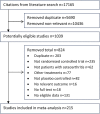Examination of overall treatment effect and the proportion attributable to contextual effect in osteoarthritis: meta-analysis of randomised controlled trials
- PMID: 26882927
- PMCID: PMC5099197
- DOI: 10.1136/annrheumdis-2015-208387
Examination of overall treatment effect and the proportion attributable to contextual effect in osteoarthritis: meta-analysis of randomised controlled trials
Abstract
Objective: To examine the overall treatment effect and the proportion attributable to contextual effect (PCE) in randomised controlled trials (RCTs) of diverse treatments for osteoarthritis (OA).
Methods: We searched Medline, Embase, Central, Science Citation Index, AMED and CINAHL through October 2014, supplemented with manual search of reference lists, published meta-analyses and systematic reviews. Included were RCTs in OA comparing placebo with representative complementary, pharmacological, non-pharmacological and surgical treatments. The primary outcome was pain. Secondary outcomes were function and stiffness. The effect size (ES) of overall treatment effect and the PCE were pooled using random-effects model. Subgroup analyses and meta-regression were conducted to examine determinants of the PCE.
Results: In total, 215 trials (41 392 participants) were included. The overall treatment effect for pain ranged from the smallest with lavage (ES=0.46, 95% CI 0.24 to 0.68) to the largest with topical non-steroidal anti-inflammatory drugs (ES=1.37, 95% CI 1.19 to 1.55). On average, 75% (PCE=0.75, 95% CI 0.72 to 0.79) of pain reduction was attributable to contextual effect. It varied by treatment from 47% (PCE=0.47, 95% CI 0.32 to 0.70) for intra-articular corticosteroid to 91% (PCE=0.91, 95% CI 0.60 to 1.37) for joint lavage. Similar results were observed for function and stiffness. Treatment delivered by needle/injection and other means than oral medication, longer duration of treatment, large sample size (≥100 per arm) and public funding source were associated with increased PCE for pain reduction.
Conclusions: The majority (75%) of the overall treatment effect in OA RCTs is attributable to contextual effects rather than the specific effect of treatments. Reporting overall treatment effect and PCE, in addition to traditional ES, permits a more balanced, clinically meaningful interpretation of RCT results. This would help dispel the frequent discordance between conclusions from RCT evidence and clinical experience-the 'efficacy paradox'.
Keywords: Epidemiology; Osteoarthritis; Treatment.
Published by the BMJ Publishing Group Limited. For permission to use (where not already granted under a licence) please go to http://www.bmj.com/company/products-services/rights-and-licensing/.
Conflict of interest statement
WZ had grants from Nottingham-China Scholarship, during the conduct of the study; MD reports personal fees from Ad hoc advisory boards for osteoarthritis and gout for AstraZeneca, Menarini, Nordic Biosciences, Pfizer, outside the submitted work; no other relationships or activities that could appear to have influenced the submitted work.
Figures



References
-
- Crow R, Gage H, Hampson S, et al. . The role of expectancies in the placebo effect and their use in the delivery of health care: a systematic review. Health Technol Assess 1999;3:1–96. - PubMed
Publication types
MeSH terms
LinkOut - more resources
Full Text Sources
Other Literature Sources
Medical

